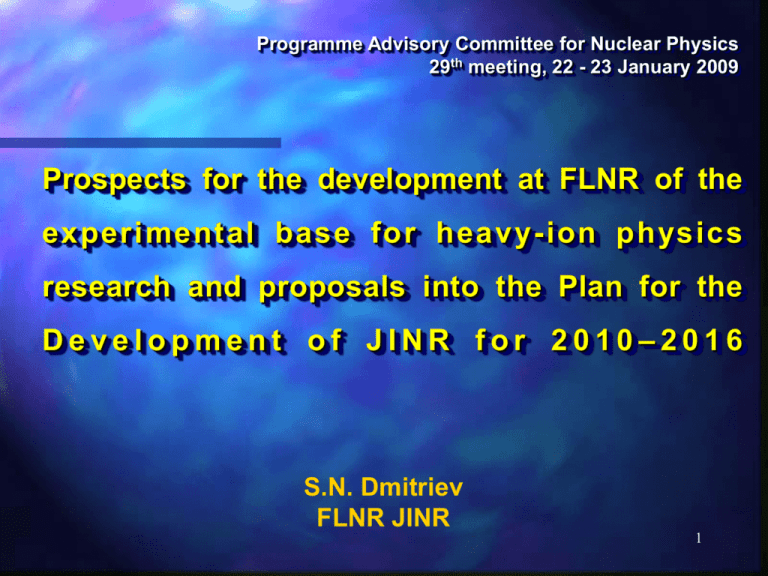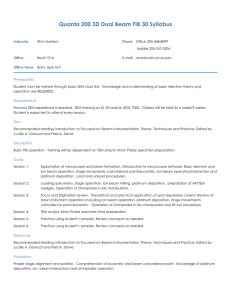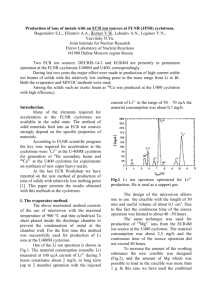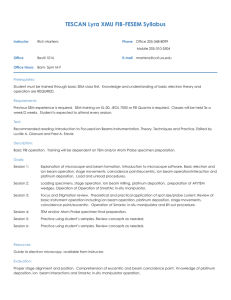ppt - JINR FLNR
advertisement

Programme Advisory Committee for Nuclear Physics 29th meeting, 22 - 23 January 2009 Prospects for the development at FLNR of the experimental base for heavy-ion physics research and proposals into the Plan for the Development of JINR for 2010–2016 S.N. Dmitriev FLNR JINR 1 Basic directions of researches Heavy and superheavy elements Synthesis and investigation of properties and structure of supeheavy isotopes; Chemistry of new elements; Fusion and fission of heavy nuclei. Nuclei in the vicinity of drip-lines Properties and structure of exotic nuclei; Reactions with exotic nuclei. Radiation effects and physical bases of nanotechnology DRIBs complex DRIBs from 2004 to 2008 2004 year Run 3 10 pps I ( He ) 7 1 pA( Li ) 6 6 2006 year Run 2 10 pps I ( He ) 7 2 pA( Li ) 7 6 52 10 pps I ( He ) 7 32 pA( Li ) 7 2008 year Run 6 Production of new RIB’s at ACCULINNA fragment separator and experiments in 2009 Primary 18O, 1pA@48 AMeV 15N, 1pA@48 AMeV (beryllium target 2mm) Secondary 11Li ~ 2*103 s-1, 35 AMeV 12Be ~ 6*104 s-1, 35 AMeV 14Be ~ 103 s-1, 35 AMeV - 15B ~ 5*104 s-1, 35 AMeV - Purpose 10He structure 12He 13Li Reaction Est.Events Date 11Li + d → 3He + 10He 200/month 12Be + 12C → 14O + 10He 50/month Jan.’09 14Be End ’09 + 12C → 14O + 12He 11Li + t → p + 13Li ? ? Operation time of the U400 cyclotron (SHE) Synthesis of Super Heavy Elements 6 Years - Total time of experiments 3 Years - Total doze of 48Ca beam 2.5 x 1020 - Average intensity of ion beam (calendar) ~ 0,5 pμA 6 Number of observed decay chains Element 118 3 Element 116 26 Element 115 4 Element 114 43 Element 113 2 Element 112 8 Planned experiments at U400 cyclotron Synthesis of superheavy nuclei: Synthesis of element Z=117: 48Ca + 249Bk (249Bk - target) 50Ti + 243Am (50Ti – beam); Search for alternative methods for synthesis of SHE, search for nuclei around N=184 closed shell: study of fusion mechanisms; use of ions heavier than 48Ca; fusion of accelerated fission fragments, multi nucleon transfer in damped collisions. 8 1 243Am 115/287 115/288 + 48Ca 16 new neutron- rich isotopes of the heaviest elements 32 ms 87 ms 2 113/283 113/284 0.10 s 249Bk 0.48 s Chemical properties of TRANSACTINIDES (relativistic effect) 3 111/279111/280 0.17 s 3.6 s 4 109/275 109/276 17 ms 0.72 s 6 5 107/272 107/272 9.8 s 7 6 105/267105/268 1.2 h 30 h 7 8 + 48Ca 8 SF Super symmetric mode of nuclear fission because of shell effect Z=50 and N=82 in both fragments Production 249Bk-target 0.35 mg/cm2 = 0.88·1018at/cm2 [total ~ 10 mg] 48Ca-beam 1 pμA = 6·1012/s time to collection beam dose 1·1019 = 19.3d total time = 40 days Collection efficiency of EVRs (DGFRS) 0.3 Cross section for 3n-4n channels ~2 pb Expected decay number: N = 0.88·1018 · 1019 · 0.3 · 2·10-36 = 5 events 10 The goal is the radical rise of overall experiment efficiency (known problems) Beam time is not sufficient; The beam intensity is not sufficient; The area of the U400 experimental hall is not sufficient (150 m2); Pure flexibility for tests and for experiments; Main experimental set-ups were build in 80-tieth; The set of accelerated particles is not sufficient; No optimum beam matching to experiments. Solution: full-scale realization of the DRIBs-project 11 DRIBs-III Modernization of existing accelerators (U400М & U400) Creation of the new experimental hall (≈ 2600 м2) Development and creation of next generation set-ups Creation of high current heavy ion accelerator (A≤ 100, E ≤ 10 MeV ·A , I≥10 pµA) 2010 - 2016 ≈ 60 М$ 12 U400M CYCLOTRON Modernization of the U400M cyclotron 1) 2) 3) 4) 5) 6) to increase the light ion beams intensity by the factor of 4 – 5 for producing of secondary beams, to improve the quality of beams, to increase the maximal energy of accelerated ions up to 100 MeV/A, to improve the radiation safety conditions, to accelerate “low” (6÷15 MeV/A) energy ions (move some experiments from U400 to U400M), to extract the beams to the second direction. 2007-2008 new axial injection line; new “warm” ECR ion source (DECRIS-2); new magnetic structure of the central region of U400MR; second beam extraction system; new producing target for secondary beams; new local radiation shielding; superconducting 18-GHz primary beam ion source DECRIS-SC2 (under testing); “warm” 14-GHz secondary beam ion source (under testing). Total modernization of the target unit 1) 2) 3) 4) 5) Development design of the disposable, nonseparable, quick-detachable, target block 6He output diagnostics from the catcher Creation of effective neutron traps around the target Adjustment of the new 14 GHz ion source Generation and acceleration of He8 New Catcher New 14 GHz Ion Source 18 Low energy beam line (2007) 19 20 21 MASHA 22 Modernization of the U400M cyclotron The main goals of modernization are achieved (the light ion beams intensity, the quality of beams, acceleration of “low” energy ions) The critical point becomes the operation stability (now is ≈50%) caused by existing infrastructure We can not modernize it we need to create the new one 23 U400 CYCLOTRON 24 U400 U400R goals 1) Beam intensity of masses A ≈ 50 and energy ≈ 6 MeV/n up to 2.5 pμA 2) Ion energy variation on the target with factor 5 3) Energy spread on the target up to 10-3 4) Beam emittance on the target – 10 π mm · mrad 5) Cyclotron average magnetic field level from 1.8 to 0.8 T 6) New equipment The project is fully prepared! Planned experiments at U400 R cyclotron Synthesis of superheavy nuclei: Synthesis of element Z=117: + 249Bk (249Bk - target) 50Ti + 243Am (50Ti – beam); Search for alternative methods for synthesis of SHE, search for nuclei around N=184 closed shell: 48Ca study of fusion mechanisms; use of ions heavier than 48Ca; fusion of accelerated fission fragments, multi nucleon transfer in damped collisions. Experiments with radioactive beams. 26 4 12 метров 3 218 219 220 12 метров 221 2600м2 222 223 Design by Bashevoy V.V. 224 226 227 1 2 3 4 Next generation experimental set-ups (under discussion) Universal gas-filled separator for synthesis and studying of properties of SHE; Preseparator for radiochemical and mass-spectrometric researches Cryogenic detector for studying chemical properties of SHE; Systems for collecting and production of single-charged ions in gas media (gas catcher); Radiochemical laboratory of II class; Separator of radioactive neutron rich nuclei for RIB production; Spectrometer for studying reactions induced by RIBs; Wide aperture spectrometer of fission fragments; ……….. 28 Os - isotopes 41.0% 41.0% 41.0% at the focal plane of MASHA Fraction % 26.4% 26.4% 16.1% 16.1% 13.3% 13.3% l foca 1.64% 1.64% beam 187 187 SC D0 D1 Q1 Q2 189 195 191 193 189 195 191 193 Isotope mass number D2 Gas Catcher ct or e t e D y arra e plan 197 197 S2 MASHA Q3 S1 D3B D3A intermediate focus 0 1 2m 29 Possible solution for a new accelerator (proposed by GSI and University of Frankfurt) IH DTL, 108 MHz RFQ, 108 MHz CH DTL, supercond. 324 MHz QWR Cavities 108 MHz Debuncher Energy MeV/u 0.3 0.003 1.4 1.8 2.4 3.3 4.2 5.2 6.1 7.1 ECR source 5 0 10 15 20 25 Z/m Main components: • Room temperature RFQ and IH-DTL at 108 MHz • Superconducting CH-DTL (324 MHz) and QWR (108 MHz) cyclic or linear? “cold” or “warm”? 30 Development of basic facilities for radiation physics, radioisotope production, material science and nanotechnological applications New innovation projects: design and construction of a specialized accelerator for BETA project, use of FLNR facilities in the frame of the International Innovation Centre on Nanotechnology and the special economic zone. Radioecological studies, production of high-purity isotopes (178mHf, 225Ac, 236Pu, 237Pu, …) 31 Time schedules & financing 2010 4,0 2011 7,0 2012 8,0 2013 8,5 2014 10,5 ≈60 М$ Modernization of existing heavy ion cyclotron U400: building of the equipment set and manufacturing of systems 2,0 installation, adjustment of systems, launching of U400R Creation of the new FLNR experimental hall requirements specification, project construction work gallery, beam lines 1,0 5,0 5,0 2,0 2015 11,0 2016 12,0 2010 2011 2012 2013 2014 2015 2016 Supporting of experiments 1.0 1.0 1.0 1.0 1.0 1.0 1.0 Development and creation of experimental set-ups of long term action (“physical” and “chemical” separators, II-class radiochemical laboratory, etc.) 1.0 2.0 2.0 2.5 2.5 5.0 5,0 5,0 Creation of high intensity heavy ion accelerator (A≤100,E≤10 MeV·A,I≥10 pµA) physical motivation, specification of requirements, project manufacturing 10,0 1,0 installation, adjustment of systems, launching 33 Development of experimental base for radiation physical and radioisotopic investigations (IC100, МТ25, U200) and new innovative projects (DC60М, DC72, ТМ, etc.) projects FLNR staff policy Staff age distribution Average age 22 - 35 35 - 45 45 - 60 More than 60 Scientific divisions (128) 50 32 (2) 15 (8) 42 (27) 39 (26) Accelerator Divisions (116) 52 14 16 (1) 59 (8) 27 (1) CAP (83) (out of budget) 50 17 8 (1) 38 (9) 20 (4) total (PhD + Doctor of Science) This year we expect presentation of 10 new dissertations (6 PhD + 4 DSc) 1. Intake of young scientists from the member states 2. Realization of 7 year program with minimal (or zero) staff increase Nuclear physics young staff training JINR University Center Nuclear department of MEPhI (Moscow) Nuclear Department of Dubna University International nuclear department of ENU (Astana, Kazachstan) @ JINR Nuclear practical training for graduate and post-graduate students at FLNR Examples of the projects proposed for students (full list is allocated on the Web page of FLNR – about 100 projects) project Structure and determination of the optimal parameters of the gasfilled separator for registering the products of complete fusion reactions degree BSc contact MSc V. Utyonkov Gamma and beta spectroscopy of isotopes of trasfermium elements at VASSILISSA separator MSc Measurement of time of flight of radioactive nuclei at ACCULINNA separator with diamond detectors MSc A. Fomichev MSc Yu. Penionzhkevich Study of neutron decay of exotic nuclei … BSc PhD A. Yeremin DRIBs-III Modernized accelerators (U400М & U400R) New experimental hall (≈ 2600 м2) Next generation set-ups High current heavy ion accelerator (A≤ 100, E ≤ 10 MeV ·A , I≥10 pµA) 2010 - 2016 ≈ 60 М$ 37 Thank you for your attention! 38







